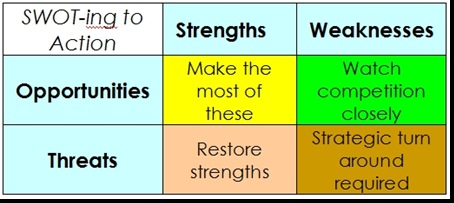SWOT is a well known planning tool for evaluating the internal competitiveness of organisations. It is also a useful technique for anyone to assess his own Strengths, Weaknesses, Opportunities, and Threats when applying for a job, choosing a course of study or even courting for a life time mate.
SWOT is valuable for the understanding the ‘elements’ within organisation and helping in decision-making. It involves stating the objective of the business or project and identifying the internal and external factors that are either supportive or unfavourable to achieving that objective.
History The SWOT analysis technique is not that old. Researcher Albert Humphrey at Stanford University in the 1960s was trying to identify why corporate planning failed in some companies. He looked into the analysis and planning methods used by big organisations and probed into their operations such as marketing and finance. He found that particularly for organisations with multiple products or services, he needed details about their people, resources, innovation, marketing, operations and finance. In the process, he developed tools to help his research, and he found the technique of SOFT – Satisfactory, Opportunity, Fault and Threat. He defined each of these elements as follows:
Positives:
- Satisfactory is for the present
- Opportunities are for the future
Negatives:
- Faults are mistakes today
- Threats are potential problems of the future
From SOFT to SWOT In 1964, management researchers Urick and Orr refined the technique and changed the F in SOFT to W, so giving birth to SWOT (or WOTS up!) and SWOT has stayed with us as that for the last 40 years. New schools of thoughts are emerging as many academics and consultants think that SWOT as a single assessment technique is not enough for business planning. They feel that extensions are need, and came up with a process of assessment which is similar to our planning cycle:
Goals or objectives setting -> SWOT -> Evaluation -> Action
Merits and Demerits Unarguably, SWOT as a planning tool has many advantages:
- It is simple
- Strengths and Weaknesses become easier to understand and to be reviewed
- It promotes strategic thinking, prompting management to focus on strengths and build opportunities, and to correct weaknesses and take action to avoid the impact of threats
- It also makes organisations more alert to new opportunities and exploit them fully.
However, SWOT may be too simple and sometimes key elements could be missed.
- Some users over simplify the amount of data needed for decisions. For an effective SWOT, managers may need vast amounts of data but data may not be easy to get especially in organisations with a complicated structure or having multiple products or services. On the other hand, too much data could cloud the scenario and points can be missed.
- SWOT has to be done by different people being involved each having a different perspective.
- To be effective SWOT needs to be a regular exercise. The pace of change is so fast that analysis will have to be done regularly.
The value of SWOT lies mainly in the fact that it promotes management to make self-assessments. The problem, however, is that the elements appear deceptively simple. Actually deciding what the strengths and weaknesses of an organisation are, as well as assessing the impact and probability of opportunities and threats, is far more complex than it appears. Indeed, a Strength could be a Weakness as well and sorting out the dilemma is not easy.
The inherent risk of making incorrect assumptions when assessing the SWOT elements often causes management to procrastinate when it comes to deciding between various strategic alternatives, frequently resulting in unnecessary and undesirable delays.
Adapted from any article by Mike Morrison
The Chartered Institute of Personnel & Development
March 2008


0 comments
Post a Comment